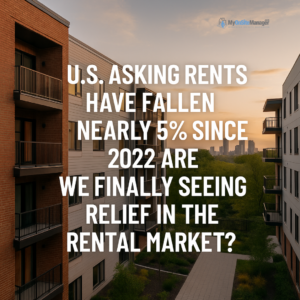After several years of intense rent spikes, bidding wars, and affordability pressure, the U.S. rental market is finally cooling and the shift is significant.
According to a new report featured by AOL Finance, the median asking rent in the U.S. has dropped nearly 5% since hitting its peak in 2022. This marks one of the first meaningful nationwide rental declines in years, and it’s reshaping how both renters and property owners navigate the market.
Let’s break down what’s happening, why it’s happening, and what it means for renters, landlords, and property managers in 2025.
The Numbers: A Closer Look at the Decline
At its height in August 2022, the median U.S. asking rent reached roughly $1,705.
As of April 2024, rents have dropped to around $1,625, according to the data cited.
That’s a 5% decrease, but the decline is even more noticeable in certain metro areas where supply is booming and demand is shifting.
Major cities with lots of new apartment construction
Pandemic-era “hot spots” where demand has normalized
Markets where affordability has hit a breaking point
These areas are experiencing notable price softening as renters become more price-sensitive and landlords adjust to new competition.
Why Are Rents Dropping? 4 Key Drivers
A Wave of New Homes & Apartments
The boom in multifamily construction from 2021–2023 is finally showing up.
Thousands of new units are hitting the market nationwide, giving renters more choices and eliminating much of the urgency seen during the pandemic.
Landlords are now competing sometimes heavily to fill their units.
The Pandemic Frenzy Has Faded
During COVID years, remote work and relocation patterns drove rent increases at unprecedented levels.
Now:
-
People are moving less
-
Remote work is stabilizing
-
Migration trends have cooled
-
Many tenants have already settled into long-term housing choices
This means less demand in markets that previously saw explosive growth.
Renters Hit an Affordability Wall
With inflation, higher living costs, and stagnant wages, many households simply cannot pay more.
Landlords in some markets discovered that units sat longer when priced too high, forcing price cuts or concessions. This affordability ceiling is a major factor in the downturn.
Regional Shifts in Demand
Some cities that were once booming are now seeing renters move out in search of cheaper alternatives. This reduces demand in high-cost metros and pushes landlords to adjust pricing.
What This Means for Renters
This is one of the best moments renters have had in years.
More leverage when negotiating
If your lease is up, you may be able to negotiate:
-
Lower monthly rent
-
Free parking
-
Waived application/admin fees
-
Move-in specials
-
Longer lease terms at a lower rate
Landlords want to retain quality tenants and now they need to work harder for it.
Better options and more availability
A renter who once had only 2–3 options may now have 10–15 solid choices in some markets.
Less competition = more freedom.
Stabilized (or even lower) renewal rates
Instead of seeing 10%–20% renewal hikes (common in 2021–2022), many tenants now receive flat renewals or small decreases.
What This Means for Property Owners & Managers
This cooling period isn’t necessarily bad but it does require strategy.
Reevaluate Your Pricing
Overpricing units leads to longer vacancies.
Competitive rents plus strong marketing = faster lease-ups.
Focus on Tenant Retention
Keeping a good tenant is cheaper than turning a unit.
Owners should prioritize:
-
Fast maintenance
-
Clear communication
-
Clean, updated units
-
Fair and transparent renewal pricing
Retention is the new revenue strategy.
Expect Longer Days on Market
In some metros, units are staying vacant longer.
Owners should prepare for:
-
Extended marketing time
-
Additional concessions
-
More competition from new developments
Strengthen Value, Not Just Price
Amenities, cleanliness, professional property management, and quick repairs now matter more than ever in attracting renters.
If your building offers true value, renters will notice.
What’s Next? Will Rents Keep Dropping?
Economists say this trend may continue through 2025, but there are factors that could reverse it:
-
Interest rates
-
Apartment construction slowdown
-
Employment growth
-
Supply delays
-
Rising demand from younger renters entering the market
The current decline is real but how long it lasts depends on broader economic pressures.
Final Thoughts
The U.S. rental market is undergoing a long-awaited correction after years of rapid growth. While this shift favors renters today, it also gives landlords and property owners a chance to reassess strategy, improve retention, and strengthen their offerings.
Whether you’re renting, managing, or investing, staying informed and adapting early will keep you ahead of the curve.
Source: https://www.aol.com/finance/asking-rents-fallen-nearly-5-210509648.html

